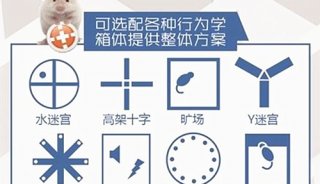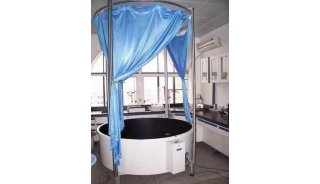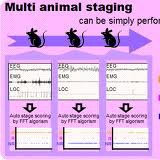动物行为轨迹分析平台
1. Morris水迷宫(Morris water maze, MWM)
Morris水迷宫实验是一种强迫实验动物(大鼠、小鼠)游泳,学习寻找隐藏在水中平台的一种实验,Morris水迷宫主要用于测试实验动物对空间位置感和方向感(空间定位)的学习记忆能力,被广泛应用于学习记忆、老年痴呆、海马/外海马研究、智力与衰老、新药开发/筛选/评价、药理学、毒理学、预防医学、神经生物学、动物心理学及行为生物学等多个学科的科学研究和计算机辅助教学等领域,在世界上已经得到广泛地认可,是医学院校开展行为学研究尤其是学习与记忆研究的首选经典实验。
2. T迷宫实验(T-maze)
T迷宫由1条干和2条臂构成。迷宫使动物在获取食物奖励时没有任何参考,只能根据自我判断选取食饵正确摆放一端。一般在测试前几天对其食量进行限制,测试前2天对动物进行训练。之后进行正式测试,每日连续测试15次,每次测试间隔1min,共测3d。
The
T-maze is a choice task. The subject is placed in the base of the
"T". Following a short delay, it is allowed to explore the maze and
choose to enter either the right or left arms. The choice is scored
according to variety of criterion, including spontaneous alternation,
cued reward, or to indicate a preference. Based on the criterion used
in an experiment, the T-maze can be used to test learning and memory,
preferences for stimuli or reward, or spontaneous alternation behavior.
3. 八臂迷宫(Radial Arm Maze)
Subjects are placed in the center of an eight-arm radial maze. Four randomly chosen arms are baited with food pellets in opaque containers. The subject is given the opportunity to visit all the arms and collect all the available food pellets. After a rentention delay, the subject is returned to the maze. In win-stay conditions, the same four arms are baited, and the number of correct choices the subject makes in collecting the pellets is recorded. In win-shift conditions, the four arms NOT baited in the earlier trial are now baited, and the number of correct arm choices is recorded. Each day, a new set of four arms is chosen randomly.
八臂迷宫用来检测药物或大脑受损状态下学习和记忆方面的表现,它由八个完全相同的臂组成,这些臂从一个中央平台放射出来,所以又被称为放射迷宫每个臂尽头有食物提供装置,根据分析动物取食的策略即进入每臂的次数、时间、正确次数、错误次数、路线等参数可以反映出实验动物的空间记忆能力。相对而言,八臂迷宫操作简便、可行,而且能区分短期的工作记忆和长期的参考记忆,现已被广泛用于学习记忆功能评价。
4. 自主活动、旷场实验(Open Field)
The subject is placed in the activity chamber for a specified time period. Activity levels and movement in three dimensions are recorded by the activity system and can be analyzed for evidence of hyperactiviy, hypoactivity, anxiety, explorative behaviors, and stereotyped rotation.
自发活动旷场旷场分析系统是观察研究实验动物神经精神变化、进入开阔环境后的各种行为,例如动物对新开阔环境的恐惧而主要在周边区域活动,在中央区域活动较少,但动物的探究特性又促使其产生在中央区域活动的动机,也可观察由此而产生的焦虑心理。中枢兴奋药物可以明显增加自主的活动而减少探究行为,一定剂量的抗精神病药物可以减少探究行为而不影响自主活动。
5. 高架十字迷宫(Elevated Plus Maze)
高架十字迷宫是利用动物对新异环境的探究特性和对高悬敞开臂的恐惧形成矛盾冲突行为来考察动物的焦虑状态。高架十字迷宫具有一对开臂和一对闭臂,高架十字迷宫距离地面较高,相当于人站在峭壁上,使实验对象产生恐惧和不安心理。高架十字迷宫被广泛应用于新药开发、药理学、毒理学、预防医学、神经生物学、动物心理学等多个学科的科学-研究和计算机辅助教学等领域,是医学院校与科研机构开展焦虑抑郁研究的经典实验。
The animal is placed in the center of the apparatus and observed for a set time. Measurements compare the include total time spent in the open and closed arms (and central platform) as well as entries into the open and closed arms.
6. 黑白箱实验(light dark box)
The subject is placed in the dark portion of the box for a set period of acclimation time. At the end of this period, a door separating the two compartments is opened. The amount of time that the subject takes to emerge fully from the enclosed area into the open area is measured.
7. 社交行为实验(social interaction)
The subject is habituated to the test chamber and allowed to freely explore for a set time. A novel animal is placed in one of the two enclosures, and the percentage of time the mouse spends in the section with the novel animal is compared to the time spent in the section with the empty enclosure. In a later session, the time spent with the same animal might be compared to time spent with a newer, more novel animal.
8. 条件性位置偏爱(Conditioned Place Preference)
条件性位置偏爱实验(CPP)实验是目前评价药物精神依赖性的经典实验模型。该实验将实验动物(大鼠、小鼠)置于条件性位置偏爱箱的白色观察区,并给予精神依赖性药物然后观察实验动物在条件性位置偏爱箱的黑色区和白色区的活动情况,白色区、黑色区以及其中的灰色区之间有小门可供动物自由穿梭。动物每次处于给药区就会在药物奖赏性效应的作用下对黑色和白色区域产生位置上的偏好,其程度与药物的精神依赖性相关。
A drug is injected and the subject is introduced to distinctive environment A. This procedure is repeated for several trials. During these conditioning trials the animal develops an association between the subjective state produced by the drug (often drugs that produce mood elevation or euphoria in humans) and the contextual cues present while the drug is active. To test the conditioning, the animal is placed in an apparatus with drug-related cues in one compartment and neutral cues in the other. nbsp; If conditioning occurred, the animal will move toward the compartment containing the drug-related cues.
In a Conditioned Place Preference experiment, subjects are returned to an apparatus were they can freely move between a compartment in which they were conditioned with drug-related cues, and a compartment with neutral cues. If the conditioning was successful for positive, reinforcing drug states, they should spend more time in the compartment with drug-related cues。
In a Conditioned Place Aversion experiment, subjects are returned to an apparatus were they can freely move between a compartment in which they were conditioned with an aversive stimulus, such as a shock; and a compartment with neutral cues. If the aversive conditioning was successful, they should spend more time in the compartment with neutral cues.
9. 强迫游泳(force swim test)、悬尾实验(tail test)
Since some mutations cause a deficit in swimming ability, the forced swim test can be used to demonstrate normal swimming and floating ability. The test is most frequently used to examine the "learned helplessness" response common in animal models of depression.
The subject is suspended by the tail for a set interval the percentage of time the subject spends still versus moving is examined for evidence of the "learned helplessness" response common in models of depression.
悬尾实验主要用于抗抑郁、镇静以及止痛类药物的研究。悬尾实验系统适用于大鼠、小鼠或其他实验室动物,通过固定动物尾部使其头向下悬挂,记录处于该环境的动物产生绝望的不动状态过程中的一系列参数。
10. 条件性恐惧实验(fear conditioning)
条件性恐惧分析用于小型啮齿类动物(大、小鼠)环境相关条件性恐惧实验研究。抗抑郁药和抗中枢兴奋药可以明显缩短不动状态持续的时间。实验过程中,实验对象被给与一个声音信号,随后给予电击刺激。该训练称为条件性训练,训练结束后实验动物进行声音信号或环境联系性实验。一般情况下啮齿类动物对相应的环境和不同环境下同样的声音信号都会做出明显的条件性恐惧反应,如静止不动。
The Pavlovian Fear Conditioning task allows for the assessment of learning and memory regarding aversive events. The task allows for the simultaneous assessment of learning about simple, unimodal cues and learning about complex, multimodal stimuli such as context. Fear conditioning universally depends on the integrity of the amygdala, but context conditioning is sensitive to manipulations of the hippocampus. This task has been used extensively to demonstrate both genetically based impairments and enhancements in learning and memory.
11. 震惊条件反射(startle and pre-pulse inhibition)
Basic Startle Response |
In basic startle, startle stimuli of various intensities are presented unexpectedly. Varying startle response and habituation are recorded. |
Pre-Pulse Inhibition |
In Pre-Pulse Inhibition (PPI), the startle stimulus is paired with a predictive cue. In normal subjects, the "pre-pulse" cue reduces the startle amplitude. This inhibition of the startle response is known as PPI. Humans and animal models of several disease states are known to have pre-pulse inhibition deficits, including schizophrenia, Alzheimer’s, and PTSD. |
Fear-Potentiated Startle |
In Fear-Potentiated Startle, the subjects are trained to associate a neutral stimulus, such as a light cue, with an aversive stimulus. When the startle response is tested in the presence of the light cue, the startle amplitude should be potentiated, or increased. |
12.新颖物体识别(novel object recognition)
The subject is habituated to the test chamber and allowed to freely explore for a set time. A novel object is placed in one of the two enclosures, and the percentage of time the mouse spends in the section with the new object is compared to the time spent in the section with the empty enclosure. In a later session, the time spent with the same object might be compared to time spent with a newer, more novel object.





























